Edmund Leighton

Edmund Blair Leighton (21 September 1852 – 1 September 1922) was an English painter of historical genre scenes, specializing in Regency and medieval subjects.
Biography

Leighton was the son of the artist Charles Blair Leighton. He was educated at University College School, before becoming a student at the Royal Academy Schools. He married Katherine Nash in 1885 and they went on to have a son and daughter. He exhibited annually at the Royal Academy from 1878 to 1920.
Leighton was a fastidious craftsman, producing highly finished, decorative pictures, displaying romanticized scenes with a popular appeal. It would appear that he left no diaries, and though he exhibited at the Royal Academy for over forty years, he was never an Academician or an Associate.
Obituary
The following obituary of Leighton is taken from a magazine published early in 1923. It is one of several publications to have given the year of birth as 1853 instead of the correct date of 1852, which error is in the process of being corrected in newer publications.[1]
Obituary - The late Edmund Blair Leighton ROI 1853–1922.
The death of Mr Edmund Blair Leighton, on September 1, removed from our midst a painter who, though he did not attain to the higher flights of art, yet played a distinguished part in aiding the public mind to an appreciation of the romance attaching to antiquity, and to a realisation of the fellowship of mankind throughout the ages.
Mr Blair Leighton was born in London, on September 1, 1853, his father being that Charles Blair Leighton, portrait and subject painter, whose exhibits at the Royal Academy and other London galleries covered the period between 1843 and 1855. The son was educated at University College School, before taking a position in an office in the city but entered the Royal Academy Schools after a course of evening study at South Kensington and Heatherley's.
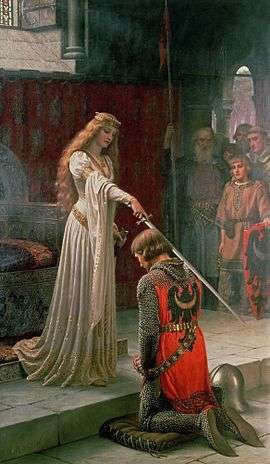
He commenced exhibiting in 1874, and succeeded, four years later, in securing the verdict of the Hanging Committee of the Royal Academy in favour of two works, entitled respectively ‘Witness My Act and Seal,’ and ‘A Flaw in the Title.’ Since then his highly wrought style was regularly represented at Burlington House until two years prior to his decease. Among the better known of his pictures, many of which were published, may be named ‘The Dying Copernicus (1880), To Arms (1888), Lay thy sweet hand in mine and trust in me ( 1891), Lady Godiva (1892), Two Strings (1893), Launched in Life (1894), The Accolade (1901), Tristan and Isolde (1907), The Dedication (1908), The Shadow (1909), ‘To the Unknown Land (1911),’ and ‘The Boyhood of Alfred The Great,’ 1913. For the past dozen years or so, Mr E Blair Leighton had been a member of the Royal Institute of Oil Painters. He had married in 1885, Miss Katherine Nash, by whom he had, with a daughter, one son, Mr E J Blair Leighton, who has also adopted painting as a profession.
List of works


- Old Times (1877), private collection.[2]
- Till Death Do Us Part (1878)
- The Dying Copernicus (1880)
- Un Gage d'Amour (1881), Auckland Art Gallery Toi o Tamaki.[3]
- Abelard and his Pupil Heloise (1882), Phillips Auctioneers, UK.[4]
- Duty (1883)
- Conquest (1884)[5]
- The Gladiator's Wife (1884), private collection.[4]
- The Rehearsal (1888), Croydon Clocktower, UK.[4]
- Call To Arms (1888), Roy Miles Fine Paintings.[4]
- A Stolen Interview (1888)
- Olivia (1888)
- How Liza Loved the King (1890), Towneley Hall Art Gallery and Museum, Burnley.[4]
- Lay thy sweet hand in mine and trust in me (1891)
- Lady Godiva (1892), Leeds City Art Gallery.[4]
- Two Strings (1893)
- Goodbye (1893)
- Launched in Life (1894)
- My Next-Door Neighbour (1894), private collection.[4]
- Waiting for the Coach (1895), Manchester Art Gallery.[6]
- A Favour (1898)
- In Time of Peril (1897)
- Off (1899), Manchester Art Gallery.[7]
- God Speed! (1900)
- On the Threshold (1900), Manchester Art Gallery.[8]
- The Accolade (1901), private collection.[4]
- Adieu (1901), Manchester Art Gallery.[9]
- Lilac (1901)
- Tristan and Isolde (AKA The End of the Song) (1902)
- Alain Chartier (1903)
- Ribbons and Laces for Very Pretty Faces (1904)
- The Dedication (1908)
- The Shadow (1909), City Hall, Cardiff[10]
- The Key (1909)
- Pelleas and Melisande (1910) Williamson Art Gallery and Museum
- To the Unknown Land (1911)
- The Boyhood of Alfred The Great (1913)
- My Fair Lady (1914)
- A Nibble (1914), private collection.[4]
- An Arrival (1916), City Hall, Cardiff[10]
- The Wedding March (1919)
- The Lord of Burleigh, Tennyson (1919), private collection.[4]
- Sweet Solitude (1919), private collection.[4]
- After Service (1921), private collection.[11]
- Signing the Register (undated), Bristol City Museum and Art Gallery.[4]
- The Fond Farewell (undated), Messum's, London.[4]
- Lord of the Manor (undated), private collection.[4]
- Sorrow and Song (undated), Bristol City Museum and Art Gallery.[4]
- Lady in a Garden
- The Charity of St. Elizabeth of Hungary
- The Rose's Day
- Stitching the Standard
- Waiting
- Cromwell dissolving the Long Parliament
- Forest Tryst
- Sweets to the Sweet
- Courtship
- Con Amore
- The Request
- The King and the Beggar-maid
Gallery
 Old Times (1877)
Old Times (1877) Till Death Do Us Part (1878)
Till Death Do Us Part (1878)
 The Elopement (1893)
The Elopement (1893) Off (1899)
Off (1899) On the Threshold (1900)
On the Threshold (1900)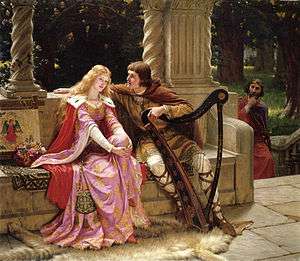 Tristan and Isolde (1902)
Tristan and Isolde (1902)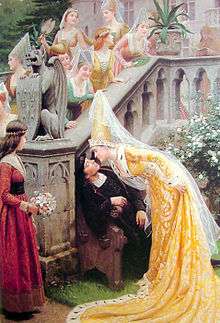 Alain Chartier (1903)
Alain Chartier (1903) Ribbons and Laces for Very Pretty Faces (1904)
Ribbons and Laces for Very Pretty Faces (1904) Courtship
Courtship My Next-Door Neighbour
My Next-Door Neighbour My Fair Lady
My Fair Lady In 1816
In 1816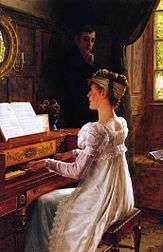 Courtship by the piano
Courtship by the piano Stitching the Standard: the lady prepares for a knight to go to war.
Stitching the Standard: the lady prepares for a knight to go to war.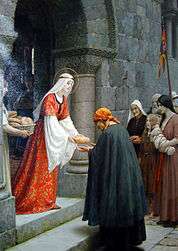 The Charity of Elisabeth of Hungary
The Charity of Elisabeth of Hungary
References
- ↑ Birth certificate 1852 St James, Clerkenwell, London.
- ↑ "Old Times by Edmund Leighton". leicestergalleries.com. Archived from the original on October 12, 2007.
- ↑ "Un Gage d'Amour". Auckland Art Gallery Toi o Tamaki.
- 1 2 3 4 5 6 7 8 9 10 11 12 13 14 15 Listed at Bridgeman Art Library.
- ↑ "Conquest". Sotheby's.
- ↑ "Waiting for the Coach". Manchester City Galleries - Search the collection.
- ↑ "Off". Manchester City Galleries - Search the collection.
- ↑ "On the Threshold". Manchester City Galleries - Search the collection.
- ↑ "Adieu painting". Manchester City Galleries - Search the collection.
- 1 2 "Visitor Information Guide" (PDF). Cardiff City Hall. 2006.
- ↑ "After Service by Edmund Leighton". leicestergalleries.com.
External links
| Wikimedia Commons has media related to Edmund Blair Leighton. |
- Edmund Blair Leighton at the Art Renewal Center where Kara Ross is researching and writing the Catalogue Raisonné for Edmund Blair Leighton.